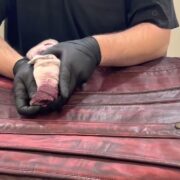Introduction:
Leather dyeing is both an art and a science. While amateurs may be content with basic dyeing methods, professionals understand the intricacies and nuances that elevate leather dyeing to a fine craft. In commercial settings, where quality and consistency are paramount, mastering advanced dyeing techniques is essential. In this blog, we’ll explore some of the sophisticated methods used by professionals in the leather industry to achieve stunning results.
Understanding Leather and Dyes:
Before delving into advanced techniques, it’s crucial to understand the basics. Leather is a natural material, and its porous nature makes it an ideal canvas for dyeing. However, achieving uniform coloration and ensuring dye penetration can be challenging without proper preparation. Professionals meticulously select the right type of leather and dye formulations tailored to their specific needs.
Advanced Techniques:
- Pre-treatment:
- Surface Preparation: Proper surface preparation is the foundation of successful leather dyeing. Professionals often use degreasers and cleaners to remove dirt, oils, and other contaminants that can inhibit dye absorption.
- Sanding and Buffing: In commercial settings, leather is often sanded and buffed to open up the pores and create a smooth, uniform surface. This step ensures better dye penetration and enhances the final finish.
- Dye Application:
- Spray Dyeing: Spray dyeing is a popular technique among professionals for its efficiency and consistency. Using specialized equipment, dye is evenly applied in thin layers, allowing for precise control over color intensity.
- Hand Rubbing: While spray dyeing is preferred for large-scale production, hand rubbing remains indispensable for custom work and intricate designs. Professionals use sponge or cloth applicators to carefully massage the dye into the leather, achieving subtle variations and blending effects.
- Color Mixing and Matching:
- Custom Color Formulation: Professionals often create custom dye formulations to meet specific color requirements. By meticulously blending primary colors and additives, they can achieve an infinite range of shades and hues, ensuring perfect color matching for bespoke projects.
- Color Testing: Before dyeing the entire piece, professionals conduct thorough color testing to ensure accuracy and consistency. This involves applying the dye to a small, inconspicuous area and assessing the results under various lighting conditions.
- Finishing Touches:
- Sealing and Protecting: Once the dye has been applied, professionals seal the color and protect the leather from wear and tear. This may involve applying clear topcoats or protective finishes that enhance durability and water resistance.
- Buffing and Polishing: Finally, the dyed leather is buffed and polished to achieve a luxurious sheen. Professionals use specialized tools and techniques to bring out the natural luster of the leather, creating a flawless finish that’s both aesthetically pleasing and long-lasting.
Conclusion:
Mastering advanced leather dyeing techniques requires skill, patience, and attention to detail. In commercial settings, where quality and efficiency are paramount, professionals rely on a combination of surface preparation, dye application, color mixing, and finishing touches to achieve stunning results. By understanding the intricacies of leather products and harnessing the power of advanced dyeing techniques, professionals can create bespoke pieces that delight customers and stand the test of time.






Comments